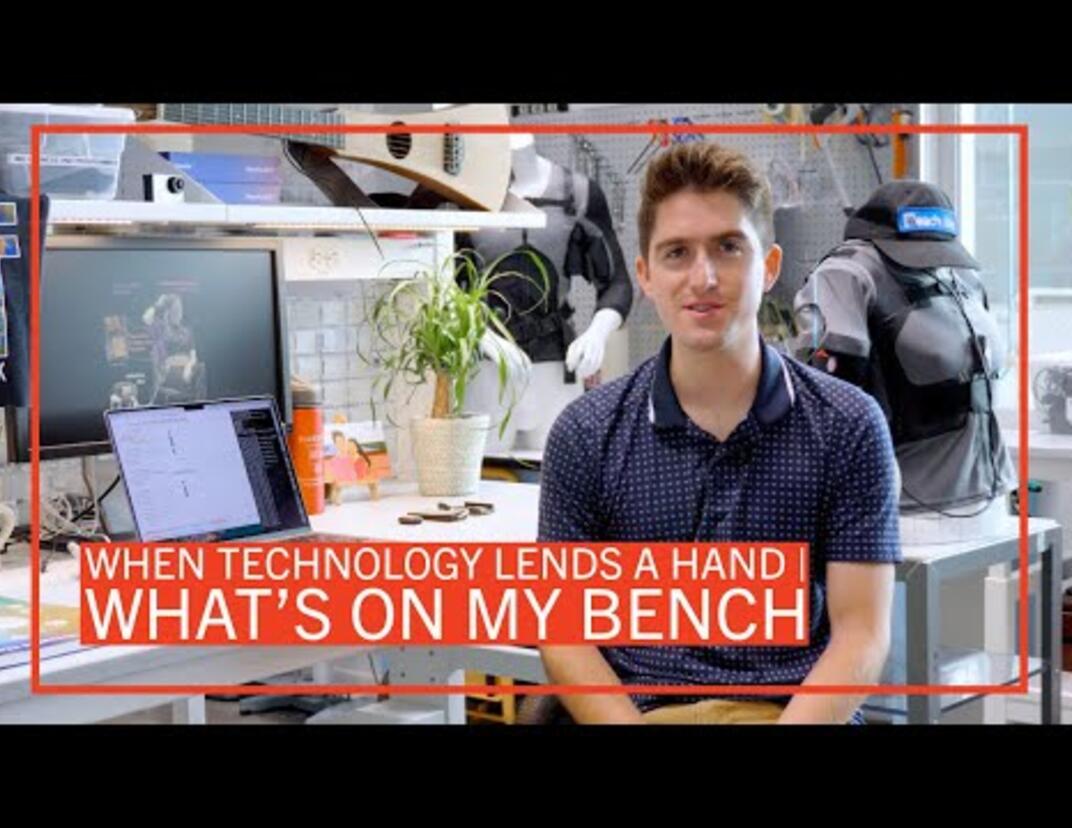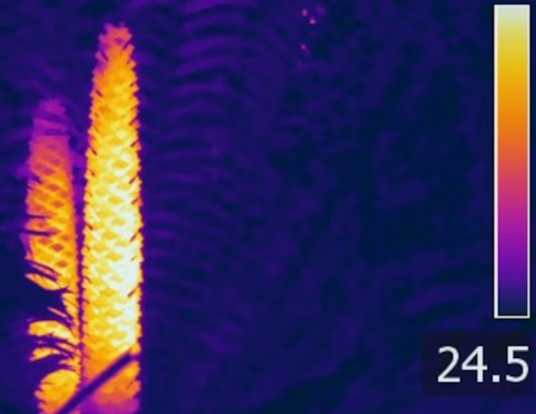A Soft Spot for Human-Centered Design
Andy Cohen looks to build robots both supple and strong to help in human environments
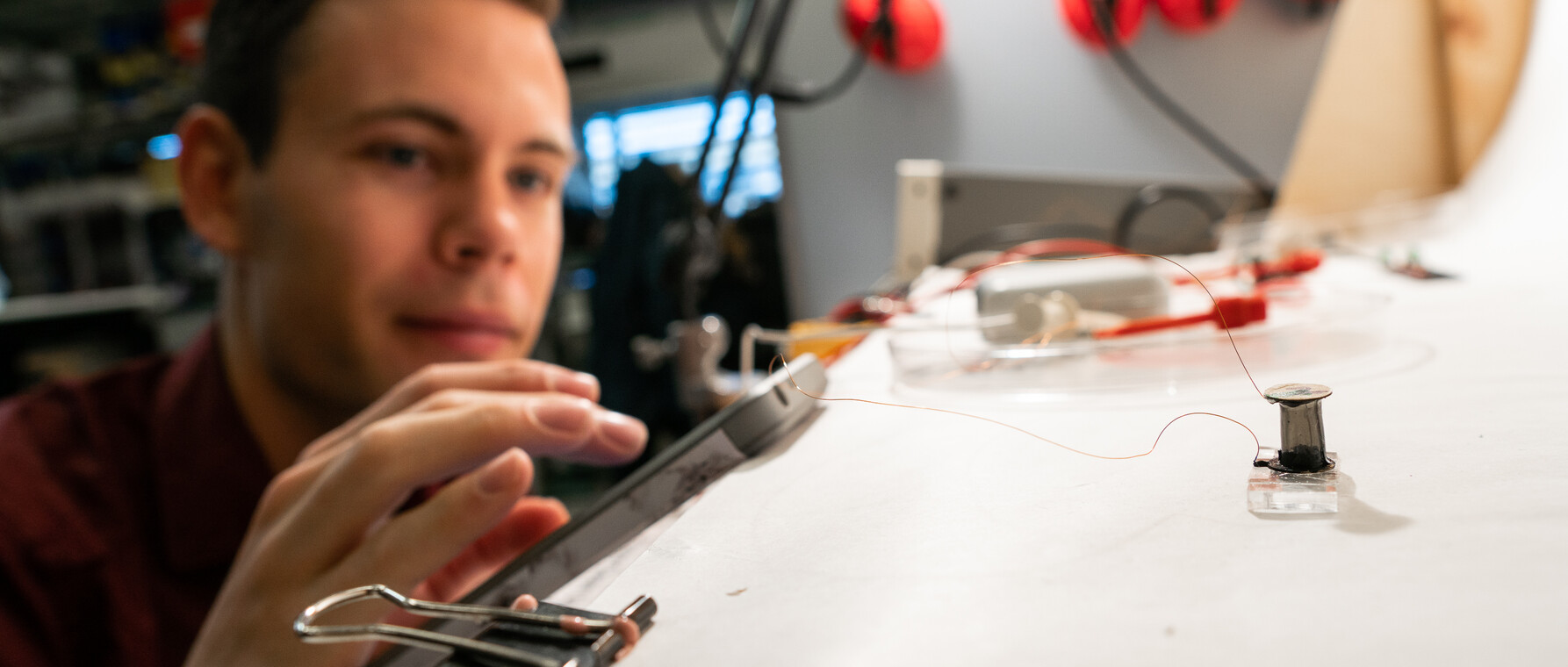
Research at Risk: Since World War II, universities have worked with the federal government to create an innovation ecosystem that has yielded life-changing progress. Now much of that work may be halted as funding is withdrawn. Find out more about the threats to medical, engineering, and scientific research, as well as how Harvard is fighting to preserve this work—and the University's core values.
Andy Cohen was stuck. He needed to get back to his undergraduate alma mater, Virginia Tech, but his flight from Charlotte, North Carolina, to Roanoke, Virginia, was canceled due to a snowstorm. He convinced some fellow travelers to rent a car with him and try to drive back, but before long they found themselves off the main highway and snowed in by the same blizzard that had grounded their plane. Rescued by a nearby fire and emergency medical services (EMS) team, Cohen and his cohorts ended up spending the night at the EMS station in Floyd, Virginia.
That evening, Cohen struck up a conversation with one of the crew. He and some classmates at Virginia Tech had actually been working on a device that would make it easier for emergency medical technicians (EMT) to lift and carry patients—a leading cause of injury among EMTs. The techs in Floyd were interested.
“EMTs use a tarp called the ‘mega mover,’” he explains. “You roll people onto it and lift. We realized the lifting part is a problem, so we made a special device that folds up or folds out from a frame with the tarp in the middle. EMTs put the frame around the patient and then use hydraulics or electric motors to lift, so they avoid injury. The crew at Floyd gave us feedback that we used to improve the design.”
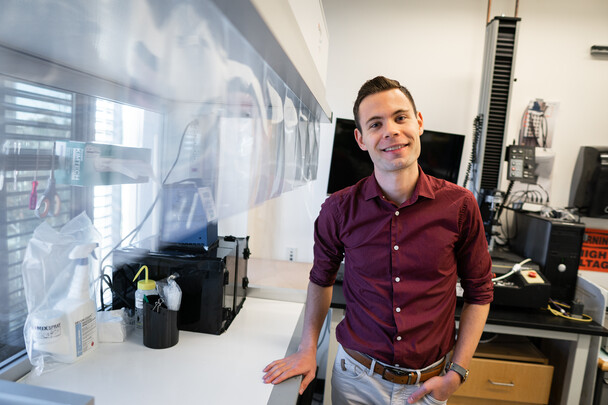
All engineers like to make things. Andy Cohen likes to make things that improve people’s lives. As a GSAS doctoral student who studies materials science and mechanical engineering at the Harvard John A. Paulson School of Engineering and Applied Sciences, Cohen brings the same passion for human-centered design to his area of focus—soft robotics—that he did to the creation of a simple device that spares the backs of first responders who work to save lives.
Creative Destruction
The motivation to look for real-world problems and find solutions through better engineering may seem self-evident, but Cohen says that he and his design teammates at Virginia Tech at first just wanted to “build cool stuff.” It was with that mindset that Cohen’s team designed a new pulse oximeter—a medical device that measures the amount of oxygen in the blood—and entered Virginia Tech’s annual competition for student entrepreneurs: The Union Innovation Challenge.
Things did not go well. The device was meant to improve surgical outcomes in the developing world where there wasn't consistent electricity, large budgets, or plentiful sanitation supplies. Cohen’s team thought that they had addressed these issues, but they had never actually spoken to potential customers about their experience in the field. Important elements in their design and business model were out of sync with the needs of the people they hoped to serve, something that the competition’s judges let them know in no uncertain terms.
“In that competition, I remember getting ripped apart by the judges in a preliminary round,” he says. “They saw that we did not think about how the device would be implemented, how we could sell it, how it would be distributed. We got absolutely destroyed. ”
For Cohen and his crew, however, the experience at the Union Innovation Challenge turned out to be an instance of creative destruction. The team learned that products must be designed and engineered in response to the needs of the people who will use them. They changed their approach and moved on to the second round of the competition with much different results.
“We won second place because we totally changed our business plan,” he says. “We changed our design. We talked to people in the field, people who had been in the hospitals we were trying to serve. We realized how much designing for people matters.”
When Cohen’s team began work on the emergency lift device, they adopted some dramatic new rules for their process. For the first semester working on the project, no one was allowed to make a design. No one was allowed to make a sketch. No one was allowed even to propose an idea.
“As engineers, our problem is that we design something and we love it,” Cohen explains. “We're like, ‘This is brilliant. This is my baby.’ And once you feel like it’s your baby, you don’t like to think about how it matches up with reality.”
Instead, Cohen and his team made about a hundred cold calls to fire and emergency rescue crews around the country asking about their needs and the challenges they faced. Some shared their thoughts, but many rebuffed them. So, when the EMS team in Floyd showed interest in the emergency lift assist device that snowy night, their feedback was exactly what Cohen had been waiting for.
“We were trying to find someone for some real face-to-face interaction,” he says. “But even the people who took our calls initially said, ‘You know this was great, but I don't really want to help anymore.’ They're busy. So, this weird coincidence with the blizzard was actually the next step that we needed.”
Even insects use soft elements for distinct purposes…Soft does not mean fragile. It actually means tough. It means resilient. It means that you can handle whatever the world spits out at you.
When Soft Means Tough
As it happened, Cohen’s ill-fated—but fortuitous—trip to Virginia was the return leg of a visit to Harvard to explore PhD programs at GSAS. His dream at the time was to “find a problem, solve it, and start my own business” and he wanted to do doctoral work in an area that had clear potential for real-world applications. Cohen was interested in robotics, but he was unsure where to focus his efforts. Then he took a course in animal locomotion and got excited about how the natural world could inform soft robotics.
“Every single animal is soft,” he says. “Even insects use soft elements for distinct purposes. Cockroaches are a great example. Their legs are super soft. That's how they get around obstacles and scatter so quickly without getting tipped over. Soft does not mean fragile. It actually means tough. It means resilient. It means that you can handle whatever the world spits out at you.”
Hard robots work well in controlled environments where tasks are clearly laid out and routinized—think of a factory floor, a conveyor belt, or a warehouse. In less predictable environments—think of a hospital or even a home—they can be a hazard. Cohen says that there are almost endless applications for robots that have few or no rigid components.
“You could make better spacesuits out of active soft robots that you wear,” he says. “You could make better surgical robots that don't injure patients or doctors. You could make robots that could assist with agriculture or search and rescue operations. Those are the kind of robots I want to build.”
However, the suppleness that is a soft robot’s greatest advantage is also the greatest challenge for engineers like Cohen. That’s because, up to now, a machine’s flexibility has usually come at the expense of its strength. Now in his third year at GSAS, Cohen wants to change that trade-off. Drawing on the lessons of animal physiology, the doctoral student is trying to create robot “muscles” that are both soft and strong.
“My research is on actuation—movement,” he explains. “I work on a class of soft actuators that are also extremely strong. Because they’re both soft and strong, these actuators are often referred to as a type of ‘artificial muscle.’ I’m trying to combine individual muscles into a much more complex musculature that can produce an array of movements without requiring a rigid skeleton like traditional robots. I’m also working on a fabrication process that could produce soft robots quickly and at scale.”
By applying high-voltages across highly elastic polymers—elastomers—Cohen can get the rubbery material to contract and relax, much like a muscle. The catch is that the polymer has to be extremely thin to carry the charge: only 10 microns. Cohen’s innovation is to try and stack thousands of these elastomer layers on top of one another until they are thick enough to be useful for applications, a painstaking process.
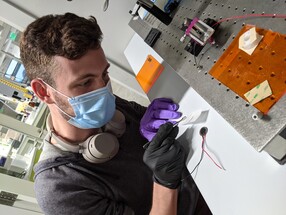
“To make even a small muscle—maybe a centimeter tall—with current technology would be a thousand layers,” he says. “It’s really hard to make without breaking the thin elastomer layers and without getting dust in them or having issues with bad electrical connections.”
Charles River Professor of Engineering and Applied Sciences Rob Wood, Cohen’s advisor, says that artificial muscles represent one of the great challenges in robotics. Cohen’s work could advance the creation of robots for tasks that require delicacy and strength and increase their impact in a range of fields through large-scale manufacturing.
“We have had recent breakthroughs working with [SEAS Professor] David Clarke’s group on the development of actuators which, for the first time, demonstrated characteristics similar to muscle,” Wood says. “However, these actuators were created with a manual, time-consuming, and artisanal process that made them impractical. Andy has recently developed a process to dramatically increase throughput and decrease the skill required to construct these devices. This is a significant advance.”
In the years ahead, Cohen hopes to further develop a process for fabricating artificial muscles quickly, easily, and in quantity. He also hopes to make larger muscles useful for full-scale robots—maybe even big enough to do the lifting for those EMTs who pulled him out of the snow back in Floyd, Virginia.
“Imagine robot arms that are soft yet strong and can move patients in a way that doesn’t hurt them—or the first responders, nurses, and doctors trying to help them,” he says. “That’s the future I’m trying to create. I think there will be a lot of progress in the years ahead.”
Photos Courtesy of Andy Cohen
Get the Latest Updates
Join Our Newsletter
Subscribe to Colloquy Podcast
Simplecast


